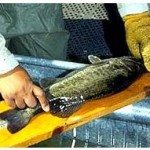 In order for special regulations such as slot-based size limits to be effective, you have to have anglers that are willing to harvest fish within or around that slot. Given that the catch and release rates for bass have, on many waters around the country, grown to over 90%, potentially changing to such a regulation can be a challenge. If anglers don’t harvest fish, you don’t get the intended change in the structure of the fish community, and a poor fishery can remain that way for an extended period of time.
In order for special regulations such as slot-based size limits to be effective, you have to have anglers that are willing to harvest fish within or around that slot. Given that the catch and release rates for bass have, on many waters around the country, grown to over 90%, potentially changing to such a regulation can be a challenge. If anglers don’t harvest fish, you don’t get the intended change in the structure of the fish community, and a poor fishery can remain that way for an extended period of time.
Indiana fishery biologists imposed a temporary 10- to 14-inch harvest slot limit at two natural lakes to determine if anglers could be encouraged to remove enough surplus bass within a short period of time to impact largemouth bass abundance and size. Based on sampling conducted by DNR biologists, Big and Crane lakes (Noble County) contained three times the typical number of bass found in other northern Indiana natural lakes. During sampling with fish shocking equipment, 303 adult bass were captured per hour at Big Lake and 294 per hour at Crane Lake. At most lakes in the area, the average bass catch rate is 96 per hour. Only 2 percent of the bass at Big Lake and 5 percent of the bass at Crane Lake were 14 inches or larger. The 14″ limit that had been in place had been overly protective at these two lakes. As a result, bass grew slowly in both lakes, and few bass ever reached the minimum (14″) size limit. Thinning out of the population would prove beneficial to the long term health of the bass fishery on these waters. As it turned out, the project was pretty successful.
According to the data, anglers removed 8.4 and 21.8 bass/acre within 90 days, representing 44% and 54% of the estimated number of 10″-14″ bass present at each lake, respectively. This translated into a 41% and 71% decrease of that 10″-14″ bass population within one year, and the electrofishing catch/hour (rate) dropped 27% and 58%, respectively.
This demonstrated that shorter length harvest slot limits could provide an alternative to more long term protected slot limits or other length-based regulations, and that anglers and angler behavior can continue to play a role in managing largemouth bass populations and size structure via harvest. It also acts as a reminder of why regulations are often put into place to begin with, being that if left uncontrolled, it is very possible for anglers to harvest half or more of available bass of a certain size range within a short period of time (a season or less), thereby potentially damaging the overall quality of the fishery.
























